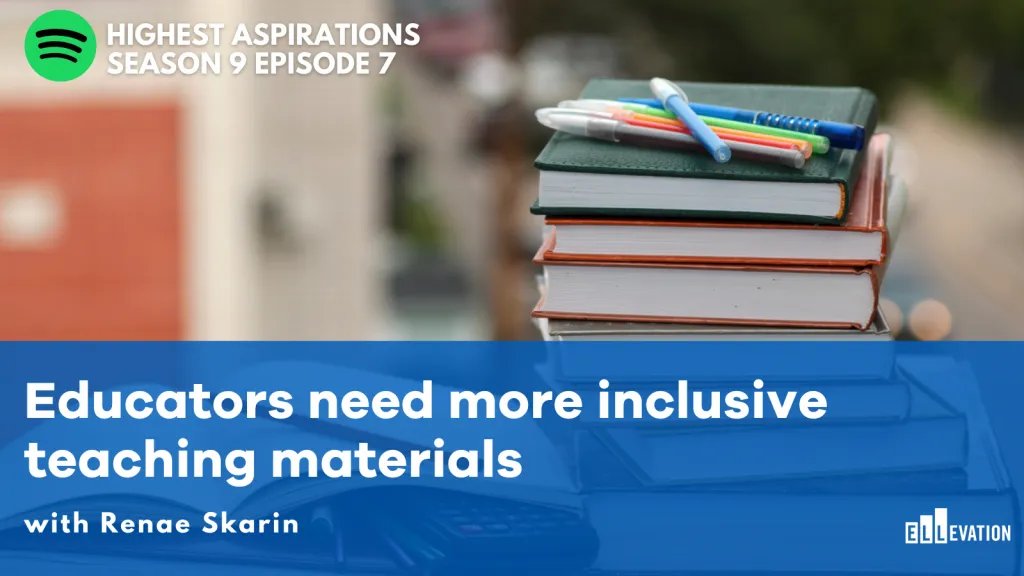Educators need more inclusive teaching materials


Educators need more inclusive teaching materials
Our education workforce is facing all-time high levels of burnout. One major contributing factor is the amount of effort and time teachers spend on finding or creating supplemental materials for their lessons when their curriculum provided by the district doesn’t have what they need. Teachers’ needs for a curriculum that is inclusive and structured with the success of multilingual learners in mind is often not met.
We spoke with Renae Skarin, Senior Director, Content at the English Learners Success Forum, who shares important findings of a survey investigating where teachers’ needs are not currently being met on their curriculum and language supports.
What challenges are teachers facing with the curriculum often provided by their district regarding multilingual learner instruction?
From the survey, Renae and her team found a concerning statistic: only 36% of teachers surveyed are using their instructional materials provided by their district on a daily basis.
“They're creating their own materials or they're using materials that they find on the internet, and many cited lack of quality supports to meet the needs of their multilingual learners. They lack effective scaffolds for multilingual learners built into the curriculum and their materials are not culturally responsive or sustaining, they don't reflect the diversity of students in their classrooms.”
Studies have shown that culturally responsive and reflective curriculum improves instruction and supports better student outcomes, so without resources that meet these standards teachers and students will continue to struggle. Educators surveyed also voiced frustration with lack of supportive tools to measure growth for language learners.
“There's not a lot of support for formatively assessing students' language and content development. So if they don't know how to assess where students are at with their language around the disciplinary subject, they don't know how to get them to where they need to be.”
What are educators doing to supplement when their curriculum is not meeting their needs?
Renae’s team found that 70% of the teachers surveyed do not feel fully prepared to support multilingual learners in learning grade level content and as a result, they are seeking out and compiling or creating their own resources to supplement. Not only do the additional 7+ hours of work spent on this each week contribute to burnout, but most educators do not have the training to ensure that what they are finding or creating are truly high quality instructional materials.
“If they are not professionally prepared through their pre-service or in-service programs, if they're not professionally prepared to teach them, how can they possibly develop coherent quality supports for multilingual learners in the curriculum that they're developing? And it's not to blame teachers at all. What teachers need is coherence in curriculum, and they need a curriculum that provides sustained language and content support in a coherently designed unit and year curriculum. But I wonder how well they can accomplish this with all the other responsibilities put on them with the lack of professional development around the diversity of students in their classroom.”
What role do stakeholders such as content creators, educational leaders and community advocates play in improving curriculum?
Renae shares that there are a number of stakeholders who are involved in the development and implementation of more inclusive teaching and learning materials that represent the diversity of the student population while supporting the needs of educators. A theme across the board is the need for diverse representation at all levels of decision making, including EL specialists at the district level and even involving educators in the selection of materials and curriculum to ensure their needs will be met.

Where are we already seeing positive changes in inclusive curriculum that can serve as a guidepost for other states?
Renae shares that the California math framework is something their team is excited about. Many of their advocates in the field have been pushing the framework developers and the California DOE to ensure that the diversity of students are reflected in that and that more equity is brought to math, which can hopefully set a standard for other states to follow suit.
“One of the bright spots there is taking an assets-based perspective on multilingualism and multiliteracy and really asking educational organizations to really support this idea of multilingualism, that multilingualism is a benefit, it's an asset. It not only helps individuals in many different ways, but it also supports the state and not only celebrating diversity, but making our system stronger.”
Download the full episode transcript here.
Episode resources:
- Learn more in Renae's article on EdSource
- Find out more about her work on English Learners Success Forum